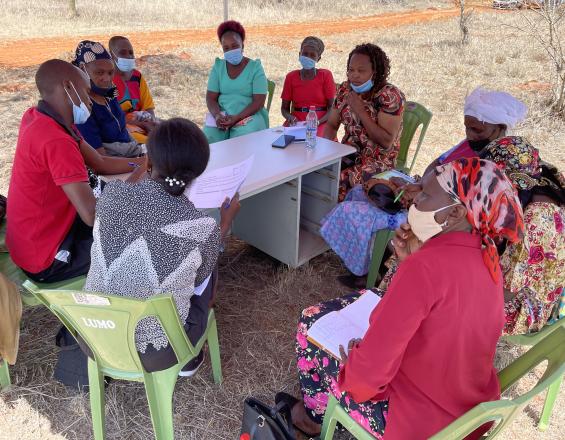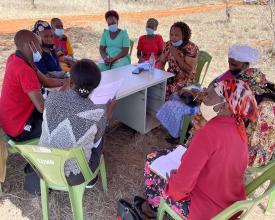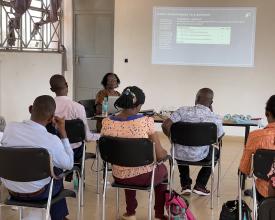Évaluation de la gouvernance et de l'équité des conservatoires de Lumo et de Satao Elerai pour améliorer les résultats en matière de conservation et de développement.

Les conservatoires d'espèces sauvages du Kenya sont confrontés à plusieurs défis liés à la gouvernance, tels que les préjugés à l'encontre des femmes et des jeunes, le manque de reconnaissance et de respect des droits de tous les acteurs concernés, l'absence de participation pleine et effective de tous les acteurs concernés à la prise de décision, le manque de transparence, de partage de l'information et de responsabilité de la part des autorités, ainsi que l'absence de partage équitable des bénéfices. La Kenya Wildlife Conservancies Association (KWCA) a donné la priorité à l'évaluation de la gouvernance et de l'équité parmi les conservatoires membres en vue d'identifier et de mettre en œuvre des actions pour une conservation efficace de la biodiversité et l'amélioration des moyens de subsistance des communautés. En 2021, la KWCA, grâce au soutien des petites subventions techniques pour l'évaluation du BIOPAMA, a soutenu le déploiement de l'outil SAGE dans la Lumo Community Wildlife Conservancy et la Satao Elerai Conservancy afin d'identifier et de prioriser les actions visant à renforcer la gouvernance et l'équité en vue d'améliorer la biodiversité et les résultats sociaux.
Contexte
Défis à relever
Social
- Exclusion des femmes et des jeunes dans la gestion des conservatoires et les processus de prise de décision
Défis économiques
- Manque de clarté des accords de partage des bénéfices au sein des conservatoires
- Manque de possibilités de revenus alternatifs
Environnement
- Augmentation des cas de braconnage, en particulier pour la viande de brousse, en raison de la perturbation des moyens de subsistance par le COVID-19
- Surpâturage dans les zones de conservation en raison de pratiques de pâturage non planifiées
Emplacement
Traiter
Résumé du processus
Les éléments constitutifs ont été étroitement liés et se sont complétés pour assurer la réussite du processus SAGE. Une communication efficace a joué un rôle clé dans la co-identification et l'engagement des parties prenantes sur la portée du projet, ainsi que dans la sensibilisation et la formation des parties prenantes à l'outil et aux processus de SAGE.
Blocs de construction
Engagement des parties prenantes
L'évaluation de SAGE est un processus participatif impliquant tous les acteurs clés de la zone de conservation. L'identification des acteurs a été réalisée lors de la phase de planification de l'évaluation. Cette cartographie des parties prenantes a été menée par le consultant de SAGE et a impliqué la Kenya Wildlife Conservancies Association (KWCA), la Taita Taveta Wildlife Conservancies Association (KWCA landscape level Association travaillant dans le paysage de Tsavo) et l'Amboseli Ecosystem Trust (KWCA Landscape level Association travaillant dans le paysage d'Amboseli). Les groupes de parties prenantes suivants ont été identifiés et invités à participer aux ateliers d'évaluation : Les évaluations ont été suivies par un total de 99 participants.
Chaque évaluation a été suivie d'un atelier de synthèse au cours duquel chaque groupe a sélectionné deux ou trois représentants pour participer à l'atelier de synthèse. Les résultats des ateliers d'évaluation ont été présentés lors de l'atelier de synthèse et des idées d'action ont été discutées. Au total, 46 parties prenantes de deux conservatoires ont participé à l'atelier de synthèse.
L'engagement de tous les acteurs concernés dans le SAGE garantit que les acteurs sont tous entendus et investis dans les actions qu'ils décident collectivement.
Facteurs favorables
- L'identification collaborative des parties prenantes a permis de dresser une carte exhaustive de toutes les parties prenantes clés.
- Le regroupement des parties prenantes en fonction de leurs intérêts communs a créé des espaces sûrs pour que chacun (en particulier les femmes et les jeunes) puisse dialoguer ouvertement et de manière productive sur l'état de la gouvernance des conservatoires.
- Le caractère d'auto-évaluation de l'outil SAGE a favorisé l'appropriation par la communauté du processus et des actions identifiées pour la mise en œuvre.
Leçon apprise
- L'engagement efficace des parties prenantes joue un rôle clé pour assurer une compréhension commune de la portée du projet et pour favoriser une approche collaborative de la mise en œuvre du projet.
- Le regroupement des parties prenantes en fonction de leurs intérêts est un ingrédient clé pour des discussions libres et productives, en particulier pour ceux qui peuvent être marginalisés en termes de gouvernance et de processus de prise de décision.
- L'engagement efficace des parties prenantes renforce l'appropriation des processus de mise en œuvre et des produits du projet.
Formation sur l'outil SAGE
SAGE est un outil relativement nouveau pour l'évaluation de la gouvernance et de l'équité au Kenya. Le succès du déploiement dépend donc de la compréhension qu'ont les parties prenantes de l'outil, de sa portée et de son application. La KWCA a recruté un animateur principal de SAGE, formé et certifié, qui a été le fer de lance de la sensibilisation à l'outil auprès des principales parties prenantes, notamment la KWCA, les gestionnaires des deux conservatoires et les représentants de l'association paysagère.
L'outil SAGE prévoit le recrutement d'assistants facilitateurs pour aider à l'animation du SAGE et à la prise de notes. Au total, 22 co-animateurs et preneurs de notes ont été recrutés, formés et déployés pour soutenir l'évaluation et l'atelier de synthèse. Leur formation était axée sur la compréhension de l'outil SAGE, des différents principes et des questions, ainsi que sur les compétences de base en matière d'animation.
Facteurs favorables
- Le recrutement et la contractualisation d'un animateur chef de file certifié SAGE pour mener le processus.
- L'assouplissement des restrictions de mouvement du COVID-19 a permis à l'équipe de mise en œuvre du projet de se déplacer et d'organiser la formation des assistants facilitateurs sur place.
- L'identification et le recrutement participatifs des assistants facilitateurs ont permis de recruter des personnes compétentes pour soutenir le processus.
Leçon apprise
- Les animateurs adjoints de SAGE jouent un rôle de soutien essentiel dans la mise en œuvre de SAGE.
- S'agissant d'un nouvel outil dans le pays, il est nécessaire de renforcer la formation des animateurs principaux de SAGE afin d'étendre la mise en œuvre de SAGE dans le pays.
Une communication efficace
La communication a joué un rôle clé dans la réussite de ce projet. La KWCA a organisé un certain nombre de réunions virtuelles depuis les phases de planification jusqu'à la phase d'évaluation. Le choix des réunions virtuelles a été rendu nécessaire par la pandémie de covid-19 et les mesures gouvernementales associées pour contrôler sa propagation, y compris le verrouillage du pays, ce qui a perturbé la mobilité et les réunions physiques. Parmi les appels virtuels, on peut citer les réunions de planification, la réunion de démarrage avec les membres de l'association de protection de l'environnement pour améliorer la compréhension commune de la portée du projet et gérer les attentes des parties prenantes. Des réunions virtuelles ont également été organisées pour sensibiliser les principales parties prenantes à SAGE et pour dresser une carte collaborative des parties prenantes de la zone de conservation.
Le consultant principal, avec le soutien des assistants facilitateurs, a dirigé la traduction des principes et des questions de SAGE dans la langue locale afin qu'ils soient plus largement adoptés, en particulier par les parties prenantes qui ne maîtrisaient que la langue locale.
Facteurs favorables
- La traduction de l'outil dans la langue locale a permis une plus grande participation.
- Le recrutement d'assistants facilitateurs issus des communautés locales et maîtrisant les langues locales a permis une participation productive des parties prenantes, en particulier des membres des conservatoires.
Leçon apprise
- La traduction de l'outil dans la langue locale a permis une plus grande participation.
- Une communication efficace est essentielle pour favoriser une compréhension commune de la portée du projet et pour garantir une mise en œuvre réussie du projet.
- L'utilisation de la langue locale est une stratégie efficace pour garantir une participation et une adhésion locales complètes, en particulier lorsque les publics cibles ne maîtrisent que les langues locales.
Impacts
- Bien que le projet ait été mis en œuvre pendant la pandémie de COVID-19, nous avons pu mener à bien toutes les activités prévues dans les délais impartis. Ces activités comprenaient l'analyse des parties prenantes, la formation des animateurs, l'évaluation du SAGE, l'atelier de synthèse du SAGE et l'élaboration d'actions de mise en œuvre
- Le projet a touché directement plus de participants (145) que prévu initialement (60).
- La Satao Elerai Conservancy a intégré les jeunes et les femmes dans ses processus de prise de décision. Un représentant des jeunes a été inclus dans le comité de conservation et les femmes sont maintenant consultées sur les processus de prise de décision de la conservation, y compris les réunions de la conservation.
- Oza, un ranch constitutif de la zone de conservation de Lumo, inclut désormais des jeunes et des femmes dans son conseil d'administration.
- Le caractère participatif et d'auto-évaluation du processus SAGE a permis à toutes les parties prenantes, y compris les femmes et les jeunes, de participer aux processus de prise de décision des conservatoires.
Bénéficiaires
- Les membres de la conservation, y compris les femmes, les hommes et les jeunes
- Le conseil d'administration et la direction des conservatoires
- Facilitateurs adjoints de SAGE issus des conservatoires
- Investisseurs privés dans les deux zones de conservation
- ONG de conservation travaillant avec les deux conservatoires

